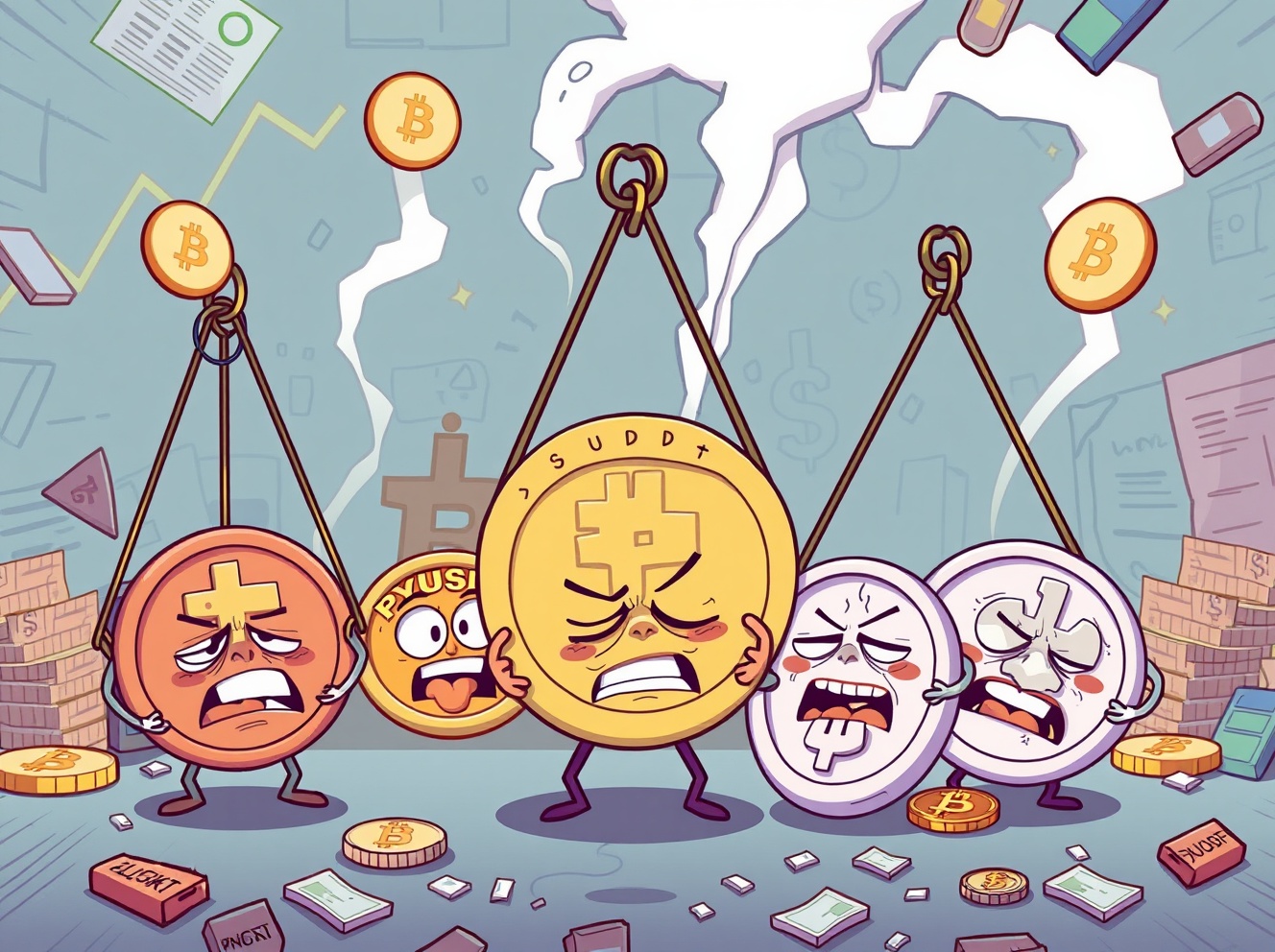Urgent Bank Crypto Regulations Face Critical Global Divide as Stablecoins Take Priority
Share:

BitcoinWorld

Urgent Bank Crypto Regulations Face Critical Global Divide as Stablecoins Take Priority
Global banking regulators face an urgent dilemma: how to create effective bank crypto regulations when major financial powers can’t agree on the approach. Erik Thedéen, Chairman of the influential Basel Committee, reveals that the traditional regulatory framework is no longer sufficient for today’s rapidly evolving cryptocurrency landscape.
Why Are Bank Crypto Regulations So Controversial?
The Basel Committee previously recommended specific risk-weighting rules for cryptocurrency holdings, but this proposal hit a major roadblock. Both the United States and United Kingdom rejected the committee’s approach, creating significant division among global financial authorities. This disagreement highlights the complex challenge of establishing unified bank crypto regulations across different jurisdictions with varying perspectives on digital assets.
Thedéen acknowledges that achieving consensus will be extremely difficult due to fundamental disagreements among regulatory bodies. The committee’s previous recommendations clearly need reconsideration, but moving forward requires bridging substantial gaps in regulatory philosophy and risk assessment methodologies.
What Changed the Regulatory Focus from Bitcoin to Stablecoins?
The conversation around bank crypto regulations has undergone a significant shift in recent months. While Bitcoin dominated previous discussions, regulators now recognize that stablecoins present more immediate concerns for financial stability. Thedéen emphasizes that stablecoins require urgent analysis and appropriate regulatory frameworks.
This shift in focus reflects the evolving nature of the cryptocurrency market and its growing integration with traditional finance. Key developments driving this change include:
- Rapid growth in stablecoin market capitalization
- Increasing bank exposure to stablecoin-related services
- Potential systemic risks from stablecoin failures
- Growing institutional adoption of stablecoins for settlements
What Challenges Prevent Global Consensus on Bank Crypto Regulations?
The wide variety of opinions among Basel Committee members creates substantial barriers to progress. Different regulatory authorities approach cryptocurrency risks from distinct perspectives, making unified bank crypto regulations increasingly challenging to achieve. Thedéen notes that further meaningful discussion remains difficult under current circumstances.
National interests and varying risk appetites contribute to this regulatory fragmentation. Some countries prioritize innovation and competition, while others emphasize financial stability and consumer protection. These divergent approaches complicate the creation of harmonized bank crypto regulations that satisfy all stakeholders.
What Does This Mean for Banks and Crypto Markets?
The ongoing regulatory uncertainty creates both challenges and opportunities for financial institutions. Banks must navigate inconsistent bank crypto regulations across different jurisdictions while managing their exposure to digital assets. This regulatory patchwork affects how banks can:
- Offer cryptocurrency custody services
- Facilitate customer crypto transactions
- Manage digital asset investments
- Comply with anti-money laundering requirements
Meanwhile, the cryptocurrency industry faces continued regulatory ambiguity that could impact market development and institutional participation.
Conclusion: The Path Forward for Bank Crypto Regulations
The urgent need for coherent bank crypto regulations has never been more apparent. As stablecoins gain prominence and traditional finance increasingly intersects with digital assets, regulatory clarity becomes essential for financial stability. However, achieving global consensus requires overcoming significant philosophical and practical differences among regulatory authorities.
The Basel Committee’s struggle highlights a critical moment for financial regulation worldwide. The outcome will shape how banks interact with cryptocurrencies for years to come, making this one of the most important financial policy debates of our time.
Frequently Asked Questions
What is the Basel Committee?
The Basel Committee on Banking Supervision is the primary global standard-setter for the prudential regulation of banks. It provides a forum for regular cooperation on banking supervisory matters among its member countries.
Why did the US and UK reject the Basel Committee’s crypto proposal?
Both countries had concerns about the specific risk-weighting approach and how it would apply to their financial institutions. They likely preferred regulatory frameworks that better aligned with their domestic financial systems and policy objectives.
Why are stablecoins now the main regulatory focus?
Stablecoins present more immediate systemic risks due to their growing use in payments and settlements, potential for rapid adoption, and connections to traditional financial systems.
How do bank crypto regulations affect ordinary investors?
These regulations influence how banks can custody crypto assets, offer crypto-related services, and manage risks, which ultimately affects product availability and safety for all market participants.
When can we expect new global crypto regulations?
The timeline remains uncertain due to significant disagreements among regulators. Progress depends on bridging substantial differences in regulatory approaches and risk assessments.
What are the main obstacles to global regulatory agreement?
Key challenges include different risk appetites, varying legal frameworks, national interests, and divergent views on innovation versus stability.
Found this analysis of bank crypto regulations insightful? Share this article with colleagues and on social media to spread awareness about these critical regulatory developments affecting the future of finance.
To learn more about the latest cryptocurrency regulatory trends, explore our article on key developments shaping global cryptocurrency policy frameworks and institutional adoption.
This post Urgent Bank Crypto Regulations Face Critical Global Divide as Stablecoins Take Priority first appeared on BitcoinWorld.
Urgent Bank Crypto Regulations Face Critical Global Divide as Stablecoins Take Priority
Share:

BitcoinWorld

Urgent Bank Crypto Regulations Face Critical Global Divide as Stablecoins Take Priority
Global banking regulators face an urgent dilemma: how to create effective bank crypto regulations when major financial powers can’t agree on the approach. Erik Thedéen, Chairman of the influential Basel Committee, reveals that the traditional regulatory framework is no longer sufficient for today’s rapidly evolving cryptocurrency landscape.
Why Are Bank Crypto Regulations So Controversial?
The Basel Committee previously recommended specific risk-weighting rules for cryptocurrency holdings, but this proposal hit a major roadblock. Both the United States and United Kingdom rejected the committee’s approach, creating significant division among global financial authorities. This disagreement highlights the complex challenge of establishing unified bank crypto regulations across different jurisdictions with varying perspectives on digital assets.
Thedéen acknowledges that achieving consensus will be extremely difficult due to fundamental disagreements among regulatory bodies. The committee’s previous recommendations clearly need reconsideration, but moving forward requires bridging substantial gaps in regulatory philosophy and risk assessment methodologies.
What Changed the Regulatory Focus from Bitcoin to Stablecoins?
The conversation around bank crypto regulations has undergone a significant shift in recent months. While Bitcoin dominated previous discussions, regulators now recognize that stablecoins present more immediate concerns for financial stability. Thedéen emphasizes that stablecoins require urgent analysis and appropriate regulatory frameworks.
This shift in focus reflects the evolving nature of the cryptocurrency market and its growing integration with traditional finance. Key developments driving this change include:
- Rapid growth in stablecoin market capitalization
- Increasing bank exposure to stablecoin-related services
- Potential systemic risks from stablecoin failures
- Growing institutional adoption of stablecoins for settlements
What Challenges Prevent Global Consensus on Bank Crypto Regulations?
The wide variety of opinions among Basel Committee members creates substantial barriers to progress. Different regulatory authorities approach cryptocurrency risks from distinct perspectives, making unified bank crypto regulations increasingly challenging to achieve. Thedéen notes that further meaningful discussion remains difficult under current circumstances.
National interests and varying risk appetites contribute to this regulatory fragmentation. Some countries prioritize innovation and competition, while others emphasize financial stability and consumer protection. These divergent approaches complicate the creation of harmonized bank crypto regulations that satisfy all stakeholders.
What Does This Mean for Banks and Crypto Markets?
The ongoing regulatory uncertainty creates both challenges and opportunities for financial institutions. Banks must navigate inconsistent bank crypto regulations across different jurisdictions while managing their exposure to digital assets. This regulatory patchwork affects how banks can:
- Offer cryptocurrency custody services
- Facilitate customer crypto transactions
- Manage digital asset investments
- Comply with anti-money laundering requirements
Meanwhile, the cryptocurrency industry faces continued regulatory ambiguity that could impact market development and institutional participation.
Conclusion: The Path Forward for Bank Crypto Regulations
The urgent need for coherent bank crypto regulations has never been more apparent. As stablecoins gain prominence and traditional finance increasingly intersects with digital assets, regulatory clarity becomes essential for financial stability. However, achieving global consensus requires overcoming significant philosophical and practical differences among regulatory authorities.
The Basel Committee’s struggle highlights a critical moment for financial regulation worldwide. The outcome will shape how banks interact with cryptocurrencies for years to come, making this one of the most important financial policy debates of our time.
Frequently Asked Questions
What is the Basel Committee?
The Basel Committee on Banking Supervision is the primary global standard-setter for the prudential regulation of banks. It provides a forum for regular cooperation on banking supervisory matters among its member countries.
Why did the US and UK reject the Basel Committee’s crypto proposal?
Both countries had concerns about the specific risk-weighting approach and how it would apply to their financial institutions. They likely preferred regulatory frameworks that better aligned with their domestic financial systems and policy objectives.
Why are stablecoins now the main regulatory focus?
Stablecoins present more immediate systemic risks due to their growing use in payments and settlements, potential for rapid adoption, and connections to traditional financial systems.
How do bank crypto regulations affect ordinary investors?
These regulations influence how banks can custody crypto assets, offer crypto-related services, and manage risks, which ultimately affects product availability and safety for all market participants.
When can we expect new global crypto regulations?
The timeline remains uncertain due to significant disagreements among regulators. Progress depends on bridging substantial differences in regulatory approaches and risk assessments.
What are the main obstacles to global regulatory agreement?
Key challenges include different risk appetites, varying legal frameworks, national interests, and divergent views on innovation versus stability.
Found this analysis of bank crypto regulations insightful? Share this article with colleagues and on social media to spread awareness about these critical regulatory developments affecting the future of finance.
To learn more about the latest cryptocurrency regulatory trends, explore our article on key developments shaping global cryptocurrency policy frameworks and institutional adoption.
This post Urgent Bank Crypto Regulations Face Critical Global Divide as Stablecoins Take Priority first appeared on BitcoinWorld.



